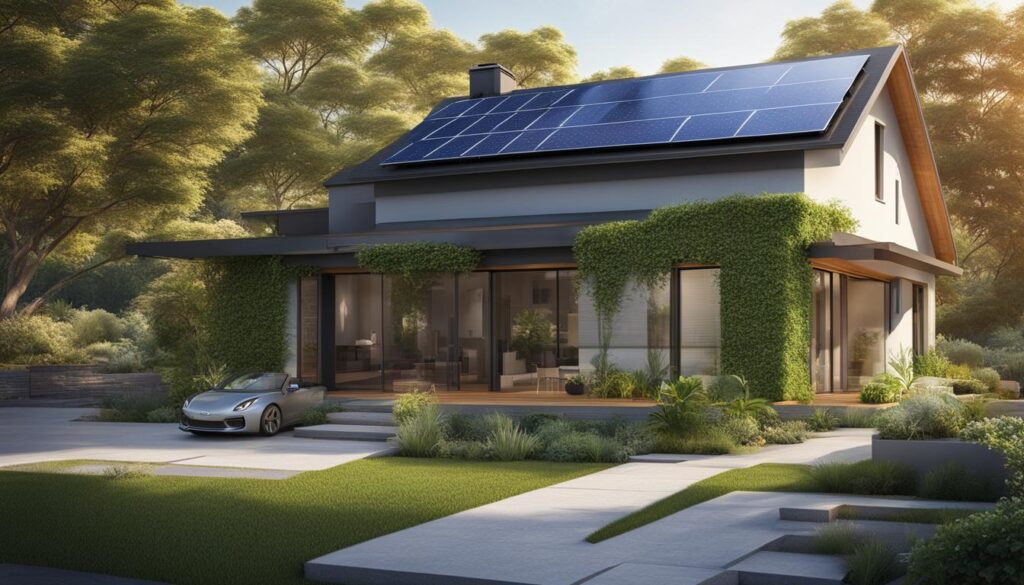Smart home technology has revolutionized the way we live, providing homeowners with efficient and sustainable solutions for modern living. In this article, I will explore the latest trends in eco-friendly smart home technology, including sustainable home automation, green living solutions, and energy-efficient home gadgets.
Table of Contents
Key Takeaways:
- Eco-friendly smart home technology is a growing trend, as homeowners seek sustainable solutions for their homes.
- Sustainable home automation allows for greater control over energy usage, reducing waste and promoting green living.
- Green living solutions, such as solar panels and energy-efficient appliances, help minimize the ecological footprint of smart homes.
- Energy-efficient home gadgets, like smart thermostats and LED lighting, contribute to cost savings and environmental sustainability.
- Embracing eco-friendly smart home technology benefits both the environment and the homeowner, providing a more sustainable and efficient living space.
Integration of Smart Home Tech
One of the top smart home trends for 2021 is the increasing integration of smart home tech. Smart home devices are now expected to be fully integrated, offering connectedness and ease of use.
Google Home speakers, for example, can function in a group to provide a multi-room audio experience. With just a simple voice command, homeowners can play their favorite music or podcasts throughout their entire home, creating a seamless and immersive entertainment experience.
The Philips Hue lighting system takes integration to the next level by allowing users to control the lights in their entire home with the touch of a button or a voice command. Whether it’s dimming the lights, changing colors, or setting up lighting schedules, homeowners have complete control over their home’s ambiance and energy efficiency.
This integration not only enhances the convenience and ease of use of smart home devices but also brings a sense of interconnectedness to the entire home. With all devices working harmoniously together, homeowners can create personalized and automated routines that cater to their specific preferences and needs.
“The integration of smart home tech allows for a more seamless smart home experience, offering homeowners convenience and control over their connected devices.”
Furthermore, the integration of smart home devices with voice assistants, such as Google Assistant or Amazon Alexa, adds another layer of convenience. Users can control their smart home devices hands-free, making it easier than ever to interact with their home’s technology.
Benefits of Smart Home Integration
The integration of smart home tech offers several benefits to homeowners:
- Enhanced convenience: By integrating all smart home devices, homeowners can seamlessly control and manage their connected devices from a central hub.
- Improved energy efficiency: Integration allows for more effective management of energy consumption, optimizing the use of lighting, heating, and cooling systems.
- Streamlined automation: With integration, users can create personalized routines and automation that simplify daily tasks and enhance comfort.
- Expanded functionality: The interconnectedness of devices opens up possibilities for unique and advanced features that enhance the overall smart home experience.
Overall, the integration of smart home tech brings a new level of connectedness and ease of use to modern homes. With devices like Google Home speakers and the Philips Hue lighting system seamlessly working together, homeowners can enjoy an enhanced and personalized smart home experience.

Artificial Intelligence and Internet of Things (IoT)
Artificial intelligence (AI) and the internet of things (IoT) play a significant role in shaping the future of smart home technology. With AI’s advanced capabilities and IoT’s connectivity, homeowners can enjoy a seamless and enhanced smart home experience. One of the notable AI features in smart homes is voice assistants, such as Amazon Alexa and Siri, which continue to evolve and improve, providing assistance and convenience with a simple voice command.
The IoT, on the other hand, enables devices to connect to the internet, creating a network of interconnected smart devices. This connectivity has paved the way for numerous possibilities, especially in the smart kitchen and smart bathroom domain. From intelligent appliances to automated processes, the integration of AI and IoT in these areas offers a range of benefits, including convenience, efficiency, and improved functionality.
AI Functionality in the Smart Kitchen
In the smart kitchen, AI functionality allows for a more intuitive and efficient cooking experience. With voice-controlled appliances, homeowners can easily control their smart ovens, refrigerators, and coffee makers. AI-powered recipe recommendations and cooking guides can assist users in creating delicious meals with precision and ease.
AI-enabled Innovations in the Smart Bathroom
In the smart bathroom, AI functionality enhances personal hygiene and comfort. Voice-activated showers and intelligent mirrors equipped with facial recognition technology can personalize water temperature, lighting, and other settings to suit individual preferences. AI-powered smart scales and wellness trackers provide real-time health insights, helping users monitor their fitness goals and overall well-being.
The integration of AI and IoT in smart home technology creates a harmonious ecosystem where devices work together seamlessly, providing an elevated level of convenience and control for homeowners. With continued advancements in artificial intelligence and the internet of things, the future of smart homes holds endless possibilities for creating a more connected, intelligent, and comfortable living environment.

| Benefits of AI and IoT in Smart Home Technology | Examples of AI and IoT in Smart Home Applications |
|---|---|
|
|
Touchless Tech
The Covid-19 pandemic has accelerated the trend of touchless technology in smart homes. Homeowners are prioritizing hygiene and safety, leading to the increased demand for touchless tech solutions. Touchless doorbells, for example, allow guests to announce their arrival without the need to touch a shared surface, reducing the potential spread of germs.
Moreover, many home devices are now smart-enabled, allowing control via mobile apps. This mobile app control minimizes the need for physical contact with the device itself, providing a convenient and touchless experience. With the touchless concept expanding, homeowners can maintain a clean and safe environment in their smart homes.
The Importance of Touchless Doorbells
Touchless doorbells have become an essential feature in modern smart homes, particularly in light of the ongoing Covid-19 pandemic. By eliminating the need for physical contact with shared surfaces, touchless doorbells help reduce the transmission of germs.
With touchless doorbells, guests can simply press the button or walk within the entrance’s proximity to announce their arrival. This technology is especially useful in shared spaces, such as apartment buildings or office complexes. Homeowners can have peace of mind knowing that they are prioritizing hygiene while still receiving notifications of visitor arrivals.
The image above showcases the convenience and modernity of touchless technology in smart homes, emphasizing the importance of touchless doorbells for a safer and more hygienic living environment.
List of Benefits of Touchless Tech:
- Minimizes physical contact with shared surfaces
- Reduces the risk of spreading germs
- Enhances hygiene and safety in smart homes
- Convenient control via mobile apps
- Suitability for shared spaces, apartments, and office complexes
| Benefits | Description |
|---|---|
| Minimizes physical contact with shared surfaces | Touchless tech eliminates the need to touch potentially contaminated surfaces, reducing the risk of spreading germs and promoting hygiene. |
| Reduces the risk of spreading germs | By implementing touchless technology, homeowners can significantly minimize the transmission of germs, creating safer living environments. |
| Enhances hygiene and safety in smart homes | Touchless tech provides homeowners with an added layer of hygiene and safety, ensuring peace of mind and a healthier living environment. |
| Convenient control via mobile apps | Many touchless devices offer mobile app control, enabling users to operate and manage their smart home devices with ease and efficiency. |
| Suitability for shared spaces, apartments, and office complexes | Touchless tech, such as touchless doorbells, is particularly beneficial in shared spaces, apartments, and office complexes, where multiple individuals interact with common surfaces. |
Smart Thermostats and Health Tech
Smart thermostats are a key component of eco-friendly and energy-saving smart homes. These innovative devices allow homeowners to easily control and adjust the temperature of their home, resulting in significant cost savings on heating and cooling expenses. By optimizing energy usage, smart thermostats contribute to a more sustainable and environmentally friendly living environment.
But the benefits of smart home technology extend beyond energy efficiency. Health tech features are gaining popularity in smart homes, offering homeowners advanced solutions for their well-being. Two notable examples are smart water filtration systems and advanced smart toilets.
Smart water filtration systems ensure that the water consumed in the home is clean, safe, and free from impurities. They utilize advanced filtration technologies to remove contaminants, providing an ongoing supply of fresh and healthy water. These systems not only enhance the drinking water quality but also contribute to the overall health of the household.
Advanced smart toilets bring technology into the bathroom, providing a range of features focused on personal hygiene and well-being. These toilets often include features such as automated flushing, heated seats, bidet functions, and even integrated air purification systems. By incorporating these advanced technologies, smart toilets offer a luxurious and healthy experience for users.
| Smart Water Filtration Systems | Advanced Smart Toilets |
|---|---|
|
|
| Embrace the latest health tech innovations in your smart home for a heightened living experience. | |
By integrating smart thermostats, smart water filtration systems, and advanced smart toilets into your home, you not only benefit from improved energy efficiency but also prioritize your health and well-being. Embrace these eco-friendly and health tech solutions to create a smart home that is both energy-saving and health-enhancing.
Conclusion
Eco-friendly smart homes have revolutionized the way we live, offering a sustainable and convenient lifestyle while promoting energy efficiency and cost savings. The integration of smart home technology has allowed homeowners to seamlessly control and connect various devices, enhancing the overall user experience.
The incorporation of Artificial Intelligence (AI) and the Internet of Things (IoT) has further elevated the capabilities of smart homes. With voice assistants like Amazon Alexa and Siri, homeowners can effortlessly interact with their smart devices, creating a more intuitive and streamlined living environment. The IoT enables connectivity between devices, making tasks easier and more efficient, especially in areas like the smart kitchen and smart bathroom.
In light of the Covid-19 pandemic, touchless technology has gained significant importance in smart homes. Touchless doorbells and mobile app control minimize the need for physical contact, contributing to improved hygiene and safety. This touchless concept extends to various other devices, ensuring the well-being of homeowners and their families.
Moreover, smart thermostats have become a cornerstone of eco-friendly smart homes, offering energy-saving benefits and cost reductions. These devices allow homeowners to effortlessly adjust their home’s temperature, optimizing energy consumption and reducing utility bills. Additionally, the incorporation of health tech features, such as smart water filtration systems and advanced smart toilets, provides not only convenience but also valuable insights into personal well-being.
In conclusion, eco-friendly smart homes have become an essential part of modern living, providing sustainability, convenience, energy efficiency, and significant cost savings. As homeowners continue to embrace these trends, the demand for smart home technology will undoubtedly grow, driving further innovation and advancements in the industry.
FAQ
How does smart home technology integrate with each other?
Smart home technology can be fully integrated, allowing for seamless control and connectivity. For example, Google Home speakers can function in a group, and the Philips Hue lighting system can control the lights in the entire home.
What are the key components of smart home technology?
Artificial intelligence (AI) and the internet of things (IoT) are key components of smart home technology. AI functionality, such as voice assistants like Amazon Alexa and Siri, enhance the user experience. The IoT connects devices to the internet, making life easier, especially in the smart kitchen and smart bathroom space.
How has the Covid-19 pandemic influenced smart home technology?
The pandemic has accelerated the trend of touchless technology in smart homes. Touchless doorbells and mobile app control allow for minimal contact with shared surfaces and devices, prioritizing hygiene and safety.
What are the benefits of smart thermostats and health tech in smart homes?
Smart thermostats offer eco-friendly and energy-saving benefits by allowing homeowners to easily adjust the temperature and save on heating and cooling costs. Health tech features, such as smart water filtration systems and advanced smart toilets, provide health benefits and insights into the user’s well-being.
How do eco-friendly smart home technology trends promote sustainable living?
Eco-friendly smart home technology promotes sustainability, convenience, energy efficiency, and cost savings. By integrating smart home tech, homeowners can reduce their environmental impact and optimize energy usage. These trends contribute to a greener and more sustainable way of living.


